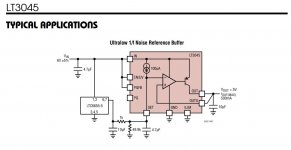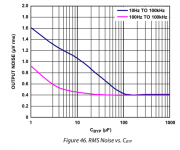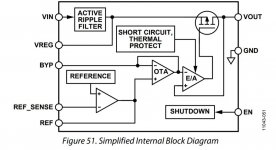Why not try using what the manufacturer recommends, at least for AVCC which is the most critical?
By the way, noise on AVCC both adds noise to the analog output of the dac, and it also mulitplies with the audio signal, which means noise on AVCC will intermodulate with the complex music signals. 10Hz is not necessarily the effective low frequency corner below which that would be a concern. It might be closer to 1Hz, don't know for sure but human brains are hardwired to notice things changing at a very few Hz.
Besides AVCC, we often don't have good data on crystal clock module PSRR vs LF phase noise. We definitely want to keep phase noise as low as possible at 1Hz. Perhaps something worth looking into.
By the way, noise on AVCC both adds noise to the analog output of the dac, and it also mulitplies with the audio signal, which means noise on AVCC will intermodulate with the complex music signals. 10Hz is not necessarily the effective low frequency corner below which that would be a concern. It might be closer to 1Hz, don't know for sure but human brains are hardwired to notice things changing at a very few Hz.
Besides AVCC, we often don't have good data on crystal clock module PSRR vs LF phase noise. We definitely want to keep phase noise as low as possible at 1Hz. Perhaps something worth looking into.
Attachments
Last edited:
Why not try using what the manufacturer recommends, at least for AVCC which is the most critical?
By the way, noise on AVCC both adds noise to the analog output of the dac, and it also mulitplies with the audio signal, which means noise on AVCC will intermodulate with the complex music signals. 10Hz is not necessarily the effective low frequency corner below which that would be a concern. It might be closer to 1Hz, don't know for sure but human brains are hardwired to notice things changing at a very few Hz.
Besides AVCC, we often don't have good data on crystal clock module PSRR for LF phase noise. We definitely want to keep phase noise as low as possible at 1Hz. Probably something worth checking on.
next time i make a es9038pro , i will accept your suggestion
yes , so i use a 22uf
Great - thanks 🙂
I found a post by Spartacus discussing implementation issues https://www.diyaudio.com/forums/digital-line-level/314935-es9038q2m-board-60.html#post5440666
and this lead me to discussion of how getting the bypass cap exactly right on the similar AD7150 got performance results very very close to lifepo4 batteries.
https://www.diyaudio.com/forums/ven...r-clock-ultra-low-noise-ocxo.html#post4062938
So I think with the right caps AND given the CCS+Shunt pre-regulator on this board, AVCC power won't be a concern.
I found a post by Spartacus discussing implementation issues https://www.diyaudio.com/forums/digital-line-level/314935-es9038q2m-board-60.html#post5440666
That link did not take me to a page with a Spartacus post.
Why not try using what the manufacturer recommends, at least for AVCC which is the most critical?
I am following the datasheets and application notes so I don't understand this comment.
By the way, noise on AVCC both adds noise to the analog output of the dac, and it also mulitplies with the audio signal, which means noise on AVCC will intermodulate with the complex music signals. 10Hz is not necessarily the effective low frequency corner below which that would be a concern. It might be closer to 1Hz, don't know for sure but human brains are hardwired to notice things changing at a very few Hz.
The lowest musical note is a C at 16.35Hz. My room acoustics do not allow the reproduction of this note or its harmonics, and my speakers can't achieve it either. I'm not aware of any important musical content at such low frequencies either, but if I ever get seasick listening to music I might give this a re-think 🙂
Besides AVCC, we often don't have good data on crystal clock module PSRR vs LF phase noise. We definitely want to keep phase noise as low as possible at 1Hz. Perhaps something worth looking into.
Absolutely - the xo won't achieve it's best performance otherwise, but the LT3042 is one of the best for this if it is implemented well with a "big" Cset cap. And let's face it, it's a Q2M not a Pro chip so it's not worth "Herculean efforts to achieve perfection" imo.
Here's another post (by IanCanada) again emphasizing that transient response is the number one priority. https://www.diyaudio.com/forums/pc-...i2s-dac-hats-raspberry-pi-32.html#post5526845
And if you couldn't get Spartacus, it's post 1194 try again https://www.diyaudio.com/forums/digital-line-level/314935-es9038q2m-board-60.html#post5440666
Last edited:
10Hz noise on AVCC intermodulating with 1kHz musical tone would produce sum and difference frequencies at 990Hz and 1,010Hz. Those are probably in the frequency range your system can reproduce quite well. Also, I don't think it's good enough to have AVCC noise at -120dB, a few microvolts out of 3.3v. Ideally, it would be better to have AVCC noise down at -130dB or -140dB if you could do it, the lower the better. The only measured results I have seen for AVCC affecting distortion were done by ESS back when they were still using opamps for the AVCC supply. Now they are promoting their own chip, ES9311Q for use with ES9038PRO. Don't know how good it is.
Last edited:
Mark, please look at the graphs and please stop asserting what is obviously not true. LT3042 has extremely low noise even at 10Hz with the correct Cset cap and other caps so intermodulation is not an issue if the implementation is correct. Of course, lower noise would be wonderful but transient response is the key.
Mark, please look at the graphs and please stop asserting what is obviously not true.
https://www.diyaudio.com/forums/dig...mate-weapon-fight-jitter-470.html#post5539433
You should put the MCLK on " L " , it will sounds much better
Does this set the SRC register in SA8804?
I guess L = 22/24.576MHz and H = 44/49.152MHz ?
Thank you.
Last edited:
According to this post about ADM7150, that huge cap doesn't actually translate into better performance. It's as if noise isn't the only piece in the puzzle, golly shock horror 🙂If you guys are so concerned about regulator noise, how come none that I can see are talking about ADM7155? With a big enough BYP cap (100uF) its noise looks considerably lower than LT304x and also ES9311 :
https://www.diyaudio.com/forums/ven...r-clock-ultra-low-noise-ocxo.html#post4062938
BTW happy mid-Autumn festival!
The guy in that post is saying the BYP cap influences the sound a lot (not really a surprise). But I suspect its at least in part capacitor microphonics which is doing it.
Incidentally I 100% agree with you that overall, output impedance is more of a concern than merely lowest noise. The ESS DACs modulate their own supplies so you'll definitely want to minimize this effect.
Thanks for the holiday wishes - I get one day off this week for the festival. Then next week is 'Golden Week' - I see more project progress in my future 😀
I've just noticed the Pulsar clock chappy is saying Oscons will make a good choice for Cbyp. I don't agree as they have rather high leakage currents which are going to push up the lower frequency noise. Better to use (rather reluctantly, given the mineral's likely provenance) a tantalum.
Incidentally I 100% agree with you that overall, output impedance is more of a concern than merely lowest noise. The ESS DACs modulate their own supplies so you'll definitely want to minimize this effect.
Thanks for the holiday wishes - I get one day off this week for the festival. Then next week is 'Golden Week' - I see more project progress in my future 😀
I've just noticed the Pulsar clock chappy is saying Oscons will make a good choice for Cbyp. I don't agree as they have rather high leakage currents which are going to push up the lower frequency noise. Better to use (rather reluctantly, given the mineral's likely provenance) a tantalum.
Last edited:
Yes, I share the same concern and also reckon a tantalum smd bypass cap is the best way to go. I might parallel a small film with them.
I also did the reading about LT3042 input and output caps. The output cap can also affect transient response and thankfully, the AVCC demand is under 10mA so voltage overshoots from large changes in current demands are not an issue. The datasheet specifies a minimum 4.7μF output capacitor with an ESR below 50mΩ and an ESL below 2nH for stability, and says larger values of output capacitance decrease peak output deviations during a load transient, and additional capacitance on the LT3042’s output helps with stability. The datasheet says a large cap will reduce the (very wide) bandwidth to something more normal – again, that’s fine in this case since the supply is a linear shunt pre-regulator and the output is for an extended audio bandwidth, not MHz digital. How large is large? The datasheet only gives data for 22uF output cap. For the input cap, LT recommend using a higher ESR tantalum or electrolytic capacitor at the LT3042 input in parallel with a 4.7μF ceramic capacitor. A quick bit of maths and a look at PSRR charts gets me thinking solid poly 470uF for both input and output with 100nF or larger ceramic bypasses will be worth trying.
I also did the reading about LT3042 input and output caps. The output cap can also affect transient response and thankfully, the AVCC demand is under 10mA so voltage overshoots from large changes in current demands are not an issue. The datasheet specifies a minimum 4.7μF output capacitor with an ESR below 50mΩ and an ESL below 2nH for stability, and says larger values of output capacitance decrease peak output deviations during a load transient, and additional capacitance on the LT3042’s output helps with stability. The datasheet says a large cap will reduce the (very wide) bandwidth to something more normal – again, that’s fine in this case since the supply is a linear shunt pre-regulator and the output is for an extended audio bandwidth, not MHz digital. How large is large? The datasheet only gives data for 22uF output cap. For the input cap, LT recommend using a higher ESR tantalum or electrolytic capacitor at the LT3042 input in parallel with a 4.7μF ceramic capacitor. A quick bit of maths and a look at PSRR charts gets me thinking solid poly 470uF for both input and output with 100nF or larger ceramic bypasses will be worth trying.
An externally hosted image should be here but it was not working when we last tested it.
What concerns me about ADMxxxx is the diagram attached below.
It appears that the bypass cap doesn't just filter the reference, it slows down the output of the whole error amplifier, which means transient response is slowed down.
For earlier versions a AVCC supplies, and what still works for mobile parts like ES9038Q2M is to use an opamp like LME49720. They are fast enough and low noise enough, etc. that they can work pretty well using them as a non-inverting buffer with a 10uf to 47uf output cap (no they don't oscillate). Last iteration with my Q2M dac involved modifying the existing opamp based supply to use LTC6655 as a reference. Not the only thing that works, but it does work.
On the other hand I took a look at what Allo is doing for AVCC with it's Katana ES9038Q2M dac. They appear to be using a fast transient response regulator with one .33F super cap and 3 or 4 different sizes of Rubycon SMD film caps in parallel with the super cap, per one AVCC channel. That part of it sounds pretty good, I think. It still has something a little off with the analog out SQ last time I listened to v1.1, but not sure where the problem is. Kind of don't think it is with AVCC.
It appears that the bypass cap doesn't just filter the reference, it slows down the output of the whole error amplifier, which means transient response is slowed down.
For earlier versions a AVCC supplies, and what still works for mobile parts like ES9038Q2M is to use an opamp like LME49720. They are fast enough and low noise enough, etc. that they can work pretty well using them as a non-inverting buffer with a 10uf to 47uf output cap (no they don't oscillate). Last iteration with my Q2M dac involved modifying the existing opamp based supply to use LTC6655 as a reference. Not the only thing that works, but it does work.
On the other hand I took a look at what Allo is doing for AVCC with it's Katana ES9038Q2M dac. They appear to be using a fast transient response regulator with one .33F super cap and 3 or 4 different sizes of Rubycon SMD film caps in parallel with the super cap, per one AVCC channel. That part of it sounds pretty good, I think. It still has something a little off with the analog out SQ last time I listened to v1.1, but not sure where the problem is. Kind of don't think it is with AVCC.
Attachments
That's a significant difference to the LT3042. I'm sure you've seen it doesn't use any error amplifier gain to set the output so noise, transient response and bandwidth are more constant than any other ldo I have seen. It also seems to happy with huge output capacitance - I'm now using Panasonic FR 1,000uF 16V with an ESR of 20mΩ and that works well 🙂 Cset is up to 15uF and I plan to try more but I've run out of time today. I finished op amp rolling and settled on OPA1612.
Not opposed to using LT3042 per se. I use one with 20uf Cset for some things. Probably worth trying the LTC6655 and LT304x combo for AVCC, too. However, at the moment I am not working on an ES90x8PRO board, so no hurry to dig into options.
Hope you enjoy your new dac. 🙂
Hope you enjoy your new dac. 🙂
Last edited:
HiThat's a significant difference to the LT3042. I'm sure you've seen it doesn't use any error amplifier gain to set the output so noise, transient response and bandwidth are more constant than any other ldo I have seen. It also seems to happy with huge output capacitance - I'm now using Panasonic FR 1,000uF 16V with an ESR of 20mΩ and that works well 🙂 Cset is up to 15uF and I plan to try more but I've run out of time today. I finished op amp rolling and settled on OPA1612.
Where do you connect the PANASONIC 1000µf16v ?
Thanks
Serge
It is connected to the output of the LT3042. The data sheet says that more than 4.7uf there is of little value and reduces regulation bandwidth, but it also says more output capacitance reduces peak deviation of output voltage during high-current-draw load transients. You can try it and see if it makes any difference for dac sound quality.
It is connected to the output of the LT3042. The data sheet says that more than 4.7uf there is of little value and reduces regulation bandwidth, but it also says more output capacitance reduces peak deviation of output voltage during high-current-draw load transients. You can try it and see if it makes any difference for dac sound quality.
I have a LT3042 for each AVCC ( L and R ) connected directly to leads of the capa (47µf) .
that means that i replace the 47µf by more .
thanks
Serge
- Status
- Not open for further replies.
- Home
- Source & Line
- Digital Line Level
- My ES9038Q2M DAC board


